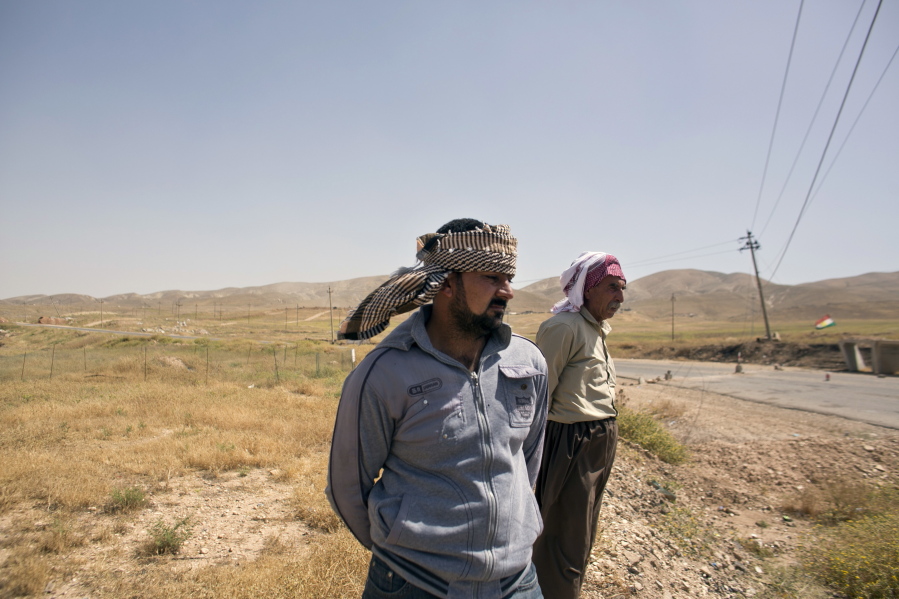HARDAN, Iraq — Peering through binoculars, the young man watched as Islamic State extremists gunned down the handcuffed men and then buried them with a waiting bulldozer. For six days he watched as IS filled one grave after another with his friends and neighbors.
The five graves arranged at the foot of Sinjar mountain hold the bodies of dozens of Yazidis killed in the Islamic State group’s bloody onslaught in August 2014. They are a fraction of the mass graves Islamic State extremists have scattered across Iraq and Syria.
In exclusive interviews, photos and research, The Associated Press has documented and mapped 72 of the mass graves, the most comprehensive survey so far, with many more expected to be uncovered as the Islamic State group’s territory shrinks.
In Syria, AP has obtained locations for 17 mass graves, including one with the bodies of hundreds of members of a single tribe all but exterminated when IS extremists took over their region.
For at least 16 of the Iraqi graves, most in territory too dangerous to excavate, officials do not even guess the number of dead. In others, the estimates are based on memories of traumatized survivors, Islamic State propaganda and what can be gleaned from a cursory look at the earth.
Still, even the known numbers of victims buried are staggering — from 5,200 to more than 15,000.
Satellites offer the clearest look at massacres such as the one at Badoush Prison in June 2014 that left 600 inmates dead. A patch of scraped earth shows the likely site, according to exclusive photos obtained by the imagery intelligence firm AllSource Analysis and shared with AP.
On Sinjar Mountain, Rasho Qassim drives daily past the mass grave in Hardan that holds the bodies of his two sons.
The sites are roped off and awaiting the money and the political will for excavation. The evidence they contain is scoured by wind and baked by sun.
“We want to take them out of here. There are only bones left. But they said ‘No, they have to stay there, a committee will come and exhume them later,”‘ said Qassim, standing at the flimsy protective fence.
IS made no attempt to hide its atrocities. But proving what United Nations officials and others have described as an ongoing genocide will be complicated as the graves deteriorate. The Islamic State group targeted the Yazidis for slaughter because it considers them infidels. The Yazidi faith has elements of Christianity and Islam but is distinct.
“There’s been virtually no effort to systematically document the crimes perpetrated, to preserve the evidence,” said Naomi Kikoler, who recently visited for the Holocaust Museum in Washington, D.C. The graves are largely documented by the aid group Yazda.
Following the release of the AP research, the State Department noted that it is providing assistance to Iraqi authorities for the investigation of mass graves.
“Sadly, we anticipate that additional mass graves will be discovered as additional lands are liberated from Da’esh,” State Department spokesman John Kirby said in a statement, using the Arabic acronym for the Islamic State group.
Through binoculars, Arkan Qassem watched it all. His village, Gurmiz, overlooks Hardan and the plain below. When the jihadis swept through, everyone in Gurmiz fled up the mountaintop. Then Arkan and nine other men returned with light weapons, hoping to defend their homes.
The first night, a bulldozer’s headlights illuminated the killing of a group of handcuffed men. Then the machine plowed over them.
Over six days, the fighters killed three more groups — several dozen each, usually with hands bound. Once, the extremists lit a bonfire, but Arkan couldn’t make out its purpose.
Two years later, the 32-year-old has since returned home, living in an area dotted with mass graves.
“I have lots of people I know there. Mostly friends and neighbors,” he said.
Nearly every area freed from IS control has unmasked new mass graves, like one found near a stadium in Ramadi. The graves are easy enough to find, most covered with just a thin coating of earth.
“They are beheading them, shooting them, running them over in cars, all kinds of killing techniques, and they don’t even try to hide it,” said Sirwan Jalal, the director of Iraqi Kurdistan’s agency in charge of mass graves.
No one outside IS has seen the Iraqi ravine where hundreds of prison inmates were killed. Satellite images of scraped dirt along the river point to its location, according to Steve Wood of AllSource. His analysts triangulated survivors’ accounts and began to systematically search the desert according to their descriptions of that day, June 10, 2014.
Justice has been done in at least one IS mass killing — that of about 1,700 Iraqi soldiers who were machine-gunned at Camp Speicher. On Aug. 21, 36 IS militants were hanged for those deaths.



